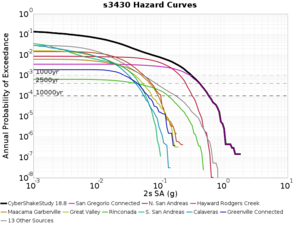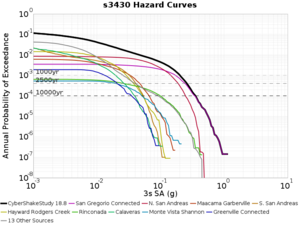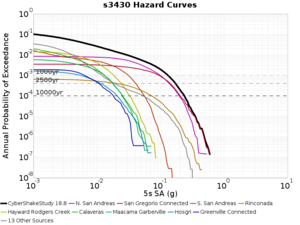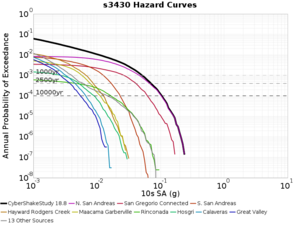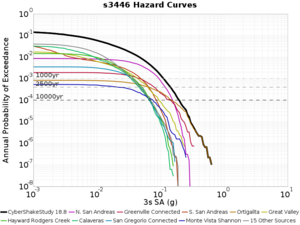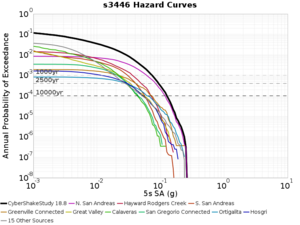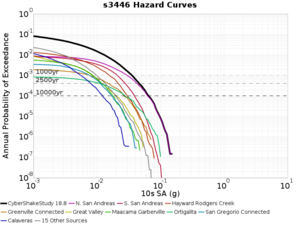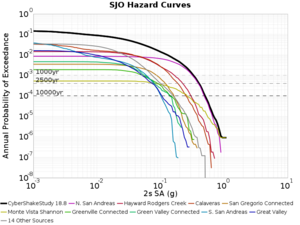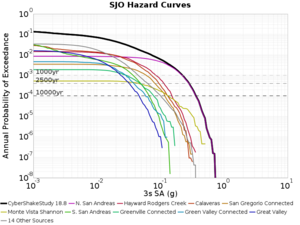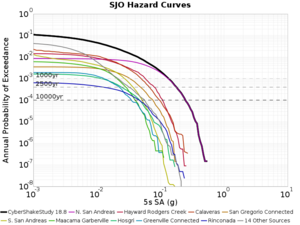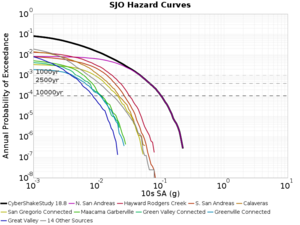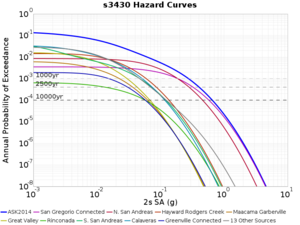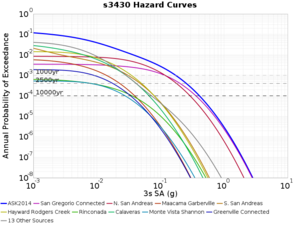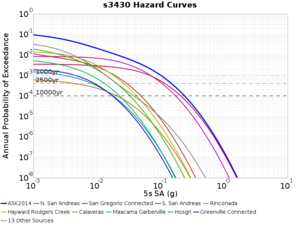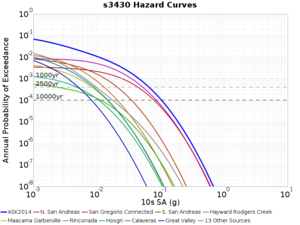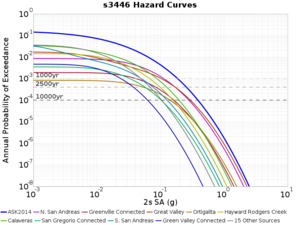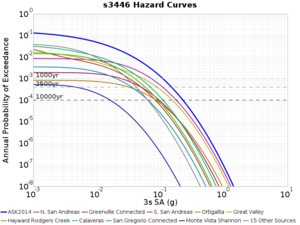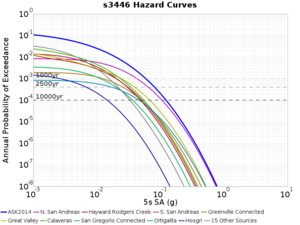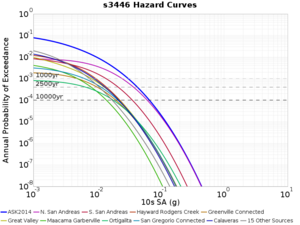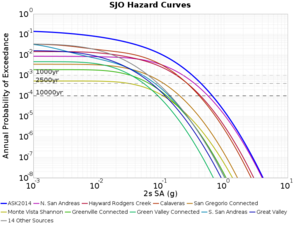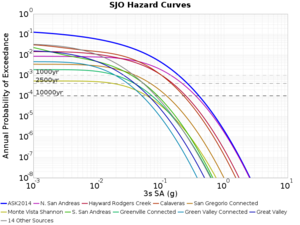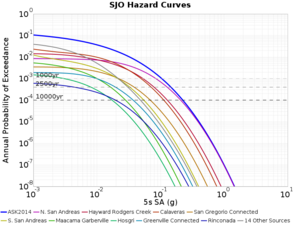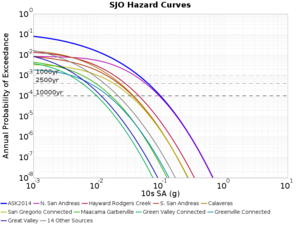CyberShake Study 24.8
CyberShake Study 24.1 is an upcoming study in Northern California which includes deterministic low-frequency (0-1 Hz) and stochastic high-frequency (1-50 Hz) simulations. We will use the Graves & Pitarka (2022) rupture generator and the high frequency modules from the SCEC Broadband Platform v22.4.
Contents
- 1 Status
- 2 Data Products
- 3 Science Goals
- 4 Technical Goals
- 5 Sites
- 6 Ruptures to Include
- 7 Velocity Model
- 8 Rupture Generator
- 9 High-frequency codes
- 10 Updates and Enhancements
- 11 Output Data Products
- 12 Computational and Data Estimates
- 13 Lessons Learned
- 14 Stress Test
- 15 Events During Study
- 16 Performance Metrics
- 17 Production Checklist
- 18 Presentations, Posters, and Papers
- 19 References
Status
This study is in the planning phase. We hope to begin this study in January 2024.
Data Products
Science Goals
The science goals for this study are:
- To perform an updated broadband study for the greater Bay Area.
- To use an updated rupture generator and improved velocity model from Study 18.8.
- To use the same parameters as in Study 22.12 when possible to make comparisons between the studies simple.
Technical Goals
The technical goals for this study are:
- Use Frontier for the SGTs and Frontera for the post-processing and high-frequency calculations.
- Use a modified approach for the production database, to improve performance.
Sites
For this study, we chose to focus on a smaller region than in Study 18.8. Starting with the Study 18.8 region, we selected a smaller (180 km x 100 km) box extending roughly from San Jose to Santa Rosa, containing 315 sites.
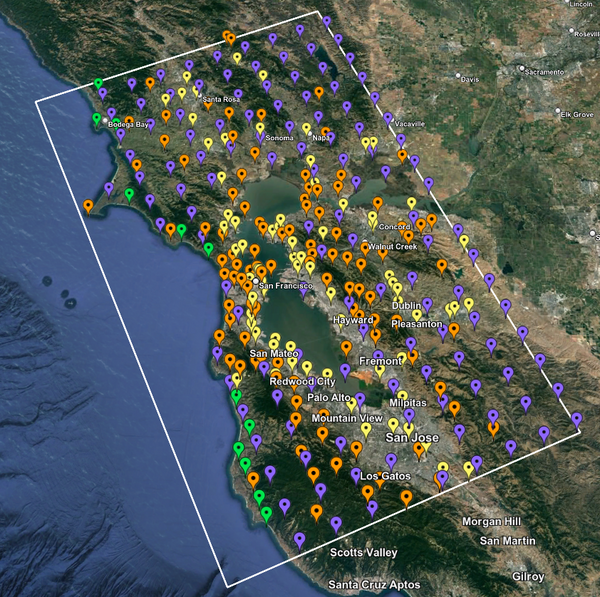
|
Ruptures to Include
Summary: we decided to exclude the southern San Andreas events from Study 24.1. This was implemented by creating a new ERF with ID 64, which includes all the ERF 36 ruptures except for the southern San Andreas events.
Historically, we have determined which ruptures to include in a CyberShake run by calculating the distance between the site and the closest part of the rupture surface. If that distance is less than 200 km, we then include all ruptures which take place on that surface, including ruptures which may extend much farther away from the site than 200 km.
For Northern California sites, this means that sites around San Jose and south include southern San Andreas events (events which rupture the northernmost segment of the southern San Andreas) within 200 km. Since there are some UCERF2 ruptures which extend from the Parkfield segment all the way down to Bombay Beach, the simulation volumes for some of these Northern California sites cover most of the state. This was the case for Study 18.8 (sample volumes can be seen on this page). This required tiling together 3 3D models and a background 1D model.
To simplify the velocity model and reduce the volumes, we are investigating omitting southern San Andreas events from this study.
Source Contribution Curves
Below are source contribution curves for 3 sites: s3430 (southwest corner of the study region), s3446 (southeast corner of the study region), and SJO (San Jose). In general, the sSAF events are about the 3rd largest contributor at long periods and medium-to-long return periods.
| Site | 2 sec | 3 sec | 5 sec | 10 sec |
|---|---|---|---|---|
| s3430 | ||||
| s3446 | ||||
| SJO |
We also looked at the source contributions for these 3 sites from ASK 2014. In general, the sSAF events play a reduced role compared to the CyberShake results.
| Site | 2 sec | 3 sec | 5 sec | 10 sec |
|---|---|---|---|---|
| s3430 | ||||
| s3446 | ||||
| SJO |
Disaggregations
From Study 18.8, we looked at disaggregations for s3430, s3446, and SJO at 1e-3 (1000 yr), 4e-4 (2500 yr), and 1e-4 (10000 yr) probability levels, at 2 and 10 seconds. We list the top 3 contributing sources from the southern SAF, their magnitude ranges, and their contributing percentages.
The only significant contributions are for site s3446 at 10 second period. Those come from large events, with median magnitude 7.85 or higher.
s3430
| Period | 1e-3 | 4e-4 | 1e-4 |
|---|---|---|---|
| 2 sec | 80 (S. San Andreas;PK, M5.65-6.35), <0.01% 81 (S. San Andreas;PK+CH, M6.75-7.35), <0.01% 82 (S. San Andreas;PK+CH+CC, M7.15-7.65), <0.01% |
80 (S. San Andreas;PK, M5.65-6.35), <0.01% 81 (S. San Andreas;PK+CH, M6.75-7.35), <0.01% 82 (S. San Andreas;PK+CH+CC, M7.15-7.65), <0.01% |
80 (S. San Andreas;PK, M5.65-6.35), <0.01% 81 (S. San Andreas;PK+CH, M6.75-7.35), <0.01% 82 (S. San Andreas;PK+CH+CC, M7.15-7.65), <0.01% |
| 10 sec | 86 (S. San Andreas;PK+CH+CC+BB+NM+SM+NSB, M7.65-8.25), 0.01% 89 (S. San Andreas;PK+CH+CC+BB+NM+SM+NSB+SSB+BG+CO, M7.75-8.45), 0.01% 85 (S. San Andreas;PK+CH+CC+BB+NM+SM, M7.55-8.15), <0.01% |
89 (S. San Andreas;PK+CH+CC+BB+NM+SM+NSB+SSB+BG+CO, M7.75-8.45), <0.01% 80 (S. San Andreas;PK, M5.65-6.35), <0.01% 81 (S. San Andreas;PK+CH, M6.75-7.35), <0.01% |
80 (S. San Andreas;PK, M5.65-6.35), <0.01% 81 (S. San Andreas;PK+CH, M6.75-7.35), <0.01% 82 (S. San Andreas;PK+CH+CC, M7.15-7.65), <0.01% |
s3446
| Period | 1e-3 | 4e-4 | 1e-4 |
|---|---|---|---|
| 2 sec | 84 (S. San Andreas;PK+CH+CC+BB+NM, M7.45-7.95), <0.01% 89 (S. San Andreas;PK+CH+CC+BB+NM+SM+NSB+SSB+BG+CO, M7.75-8.45), <0.01% 80 (S. San Andreas;PK, M5.65-6.35), <0.01% |
80 (S. San Andreas;PK, M5.65-6.35), <0.01% 81 (S. San Andreas;PK+CH, M6.75-7.35), <0.01% 82 (S. San Andreas;PK+CH+CC, M7.15-7.65), <0.01% |
80 (S. San Andreas;PK, M5.65-6.35), <0.01% 81 (S. San Andreas;PK+CH, M6.75-7.35), <0.01% 82 (S. San Andreas;PK+CH+CC, M7.15-7.65), <0.01% |
| 10 sec | 85 (S. San Andreas;PK+CH+CC+BB+NM+SM, M7.55-8.15), 6.83% 86 (S. San Andreas;PK+CH+CC+BB+NM+SM+NSB, M7.65-8.25), 4.18% 84 (S. San Andreas;PK+CH+CC+BB+NM, M7.45-7.95), 1.53% |
85 (S. San Andreas;PK+CH+CC+BB+NM+SM, M7.55-8.15), 4.27% 86 (S. San Andreas;PK+CH+CC+BB+NM+SM+NSB, M7.65-8.25), 3.09% 89 (S. San Andreas;PK+CH+CC+BB+NM+SM+NSB+SSB+BG+CO, M7.75-8.45), 1.08% |
86 (S. San Andreas;PK+CH+CC+BB+NM+SM+NSB, M7.65-8.25), 1.19% 85 (S. San Andreas;PK+CH+CC+BB+NM+SM, M7.55-8.15), 1.19% 89 (S. San Andreas;PK+CH+CC+BB+NM+SM+NSB+SSB+BG+CO, M7.75-8.45), 0.55% |
SJO
| Period | 1e-3 | 4e-4 | 1e-4 |
|---|---|---|---|
| 2 sec | 80 (S. San Andreas;PK, M5.65-6.35), <0.01% 81 (S. San Andreas;PK+CH, M6.75-7.35), <0.01% 82 (S. San Andreas;PK+CH+CC, M7.15-7.65), <0.01% |
80 (S. San Andreas;PK, M5.65-6.35), <0.01% 81 (S. San Andreas;PK+CH, M6.75-7.35), <0.01% 82 (S. San Andreas;PK+CH+CC, M7.15-7.65), <0.01% |
80 (S. San Andreas;PK, M5.65-6.35), <0.01% 81 (S. San Andreas;PK+CH, M6.75-7.35), <0.01% 82 (S. San Andreas;PK+CH+CC, M7.15-7.65), <0.01% |
| 10 sec | 85 (S. San Andreas;PK+CH+CC+BB+NM+SM, M7.55-8.15), 0.09% 86 (S. San Andreas;PK+CH+CC+BB+NM+SM+NSB, M7.65-8.25), 0.07% 89 (S. San Andreas;PK+CH+CC+BB+NM+SM+NSB+SSB+BG+CO, M7.75-8.45), 0.05% |
89 (S. San Andreas;PK+CH+CC+BB+NM+SM+NSB+SSB+BG+CO, M7.75-8.45), 0.01% 88 (S. San Andreas;PK+CH+CC+BB+NM+SM+NSB+SSB+BG, M7.75-8.35), 0.01% 86 (S. San Andreas;PK+CH+CC+BB+NM+SM+NSB, M7.65-8.25), <0.01% |
80 (S. San Andreas;PK, M5.65-6.35), <0.01% 81 (S. San Andreas;PK+CH, M6.75-7.35), <0.01% 82 (S. San Andreas;PK+CH+CC, M7.15-7.65), <0.01% |
Velocity Model
We will perform validation of the proposed velocity model using northern California BBP events.
We plan to use a minimum Vs of 500 m/s.
Rupture Generator
High-frequency codes
Updates and Enhancements
Output Data Products
File-based data products
We plan to produce the following data products, which will be stored at CARC:
Deterministic
- Seismograms: 2-component seismograms, 8000 timesteps (400 sec) each.
- PSA: X and Y spectral acceleration at 44 periods (10, 9.5, 9, 8.5, 8, 7.5, 7, 6.5, 6, 5.5, 5, 4.8, 4.6, 4.4, 4.2, 4, 3.8, 3.6, 3.4, 3.2, 3, 2.8, 2.6, 2.4, 2.2, 2, 1.66667, 1.42857, 1.25, 1.11111, 1, .66667, .5, .4, .33333, .285714, .25, .22222, .2, .16667, .142857, .125, .11111, .1 sec)
- RotD: PGV, and RotD50, the RotD50 azimuth, and RotD100 at 25 periods (20, 15, 12, 10, 8.5, 7.5, 6.5, 6, 5.5, 5, 4.4, 4, 3.5, 3, 2.8, 2.6, 2.4, 2.2, 2, 1.7, 1.5, 1.3, 1.2, 1.1, 1)
- Durations: for X and Y components, energy integral, Arias intensity, cumulative absolute velocity (CAV), and for both velocity and acceleration, 5-75%, 5-95%, and 20-80%.
Broadband
- Seismograms: 2-component seismograms, 40000 timesteps (400 sec) each.
- PSA: X and Y spectral acceleration at 44 periods (10, 9.5, 9, 8.5, 8, 7.5, 7, 6.5, 6, 5.5, 5, 4.8, 4.6, 4.4, 4.2, 4, 3.8, 3.6, 3.4, 3.2, 3, 2.8, 2.6, 2.4, 2.2, 2, 1.66667, 1.42857, 1.25, 1.11111, 1, .66667, .5, .4, .33333, .285714, .25, .22222, .2, .16667, .142857, .125, .11111, .1 sec)
- RotD: PGA, PGV, and RotD50, the RotD50 azimuth, and RotD100 at 66 periods (20, 15, 12, 10, 8.5, 7.5, 6.5, 6, 5.5, 5, 4.4, 4, 3.5, 3, 2.8, 2.6, 2.4, 2.2, 2, 1.7, 1.5, 1.3, 1.2, 1.1, 1, 0.85, 0.75, 0.65, 0.6, 0.55, 0.5, 0.45, 0.4, 0.35, 0.3, 0.28, 0.26, 0.24, 0.22, 0.2, 0.17, 0.15, 0.13, 0.12, 0.11, 0.1, 0.085, 0.075, 0.065, 0.06, 0.055, 0.05, 0.045, 0.04, 0.035, 0.032, 0.029, 0.025, 0.022, 0.02, 0.017, 0.015, 0.013, 0.012, 0.011, 0.01)
- Durations: for X and Y components, energy integral, Arias intensity, cumulative absolute velocity (CAV), and for both velocity and acceleration, 5-75%, 5-95%, and 20-80%.
Database data products
We plan to store the following data products in the database on moment:
Deterministic
- RotD50 and RotD100 for 6 periods (10, 7.5, 5, 4, 3, 2)
- Duration: acceleration 5-75% and 5-95%, for both X and Y
Broadband
- RotD50 and RotD100 for PGA, PGV, and 19 periods (10, 7.5, 5, 4, 3, 2, 1, 0.75, 0.5, 0.4, 0.3, 0.2, 0.1, 0.075, 0.05, 0.04, 0.03, 0.02, 0.01)
- Duration: acceleration 5-75% and 5-95%, for both X and Y
